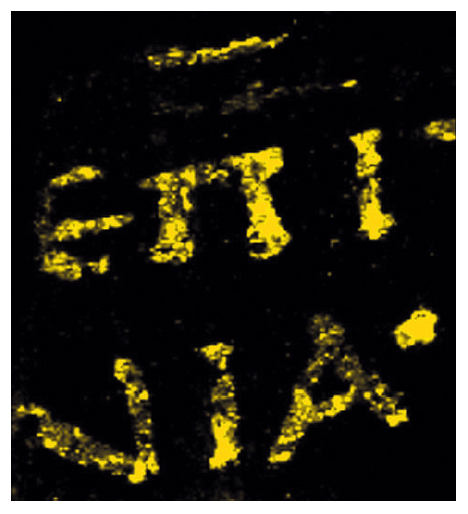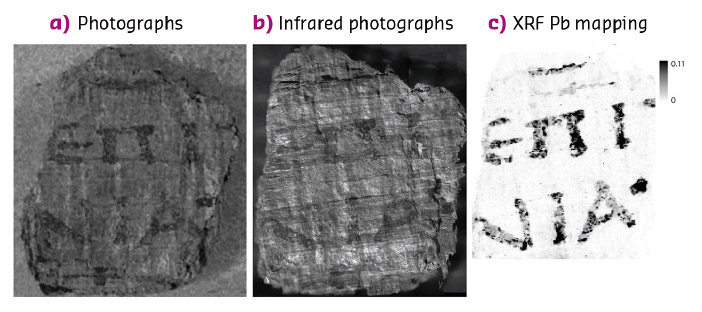- Home
- Users & Science
- Scientific Documentation
- ESRF Highlights
- ESRF Highlights 2016
- X-ray nanoprobe
- The discovery of metallic ink in Herculaneum papyri
The discovery of metallic ink in Herculaneum papyri
Fragments of Herculaneum papyri were examined using a variety of X-ray techniques. The writing on the papyri contained a high concentration of lead, which pushes back the date of introduction of lead into inks by several centuries.
In 2015, thanks to the X-ray phase contrast technique available at the ESRF, we were able to decipher a few words and recover a complete Greek alphabet from inside a rolled-up papyrus that had been charred during the Mount Vesuvius eruption in 79 AD [1].
Our study of Herculaneum papyri using synchrotron light has continued and we have focussed in particular on the materials composing the ink [2]. Our latest discovery changes our knowledge of writing in Antiquity and opens new prospects for the examination of these precious documents.
Pliny the Elder, naturalist and natural philosopher, who died during the Mount Vesuvius eruption, remarked that writing on some kind of support (e.g. papyrus) is essential to civilisation. A rigorous scientific study of writing is hence of fundamental importance for the understanding of ancient societies.
The collection of carbonised Herculaneum papyri, discovered between 1752 and 1754, represents the only complete library from Antiquity and, as such, it is a unique opportunity to understand the development of western civilisation.
In particular, it had been assumed that a carbon-based ink, described by Pliny the Elder in his Natural History, was used in Greek and Roman manuscripts and that metallic ink appears only around the fourth to fifth century AD. The ink used in Antiquity was obtained from the soot of wood burnt in furnaces without any deliberate addition of metals. Metallic ink before this period was employed only for writing secret messages in the second century BC whereas from around 420 AD a metallic iron-gall mixture was adopted as a new writing ink for parchments. Thereafter, metallic inks became the standard for parchments in late Antiquity and for most of the Middle Age.
 |
|
Fig. 36: X-ray fluorescence micro-imaging technique reveals the lead contained in the ink. |
Multi-scale X-ray fluorescence (XRF) micro-imaging at beamline ID21 demonstrated that the ink in the fragment samples exhibits a fairly high concentration of lead. In particular, it resolved the elemental composition of both ink and papyrus (Figure 36). The fragments were scanned using X-ray beams of different sizes: from the sub-millimetre down to the micrometric scale. These studies were complemented by X-ray diffraction mapping at ID11 and X-ray absorption near edge structure at BM26.
 |
|
Fig. 37: Comparison of visible light photograph (a), infrared microscopy image (b) and lead distribution map obtained by X-ray fluorescence (c). The XRF map was normalised by the incident flux, in arbitrary units. |
Figure 37 presents a fluorescence map that highlights letters in the larger sample. This means that, for Herculaneum fragments that are difficult to read, the use of spectrometric techniques sensitive to lead may render the writing more clearly. Using an iterative Monte Carlo simulation, the concentration of lead in the letters has been estimated to be as much as 84 ± 5 µg/cm2, a quite high concentration that cannot be simply attributed to lead contamination of water from Roman aqueducts, or from an inkwell. The most plausible explanation of this high concentration is that a lead-bearing material was intentionally introduced during the ink production process.
The concentrations of metal found in the ink will aid the optimisation of future tomographic experiments on undisclosed Herculaneum scrolls. More extensive research using many fragments from Herculaneum should be performed to assess the extent of lead present in the inks in Antiquity.
Principal publication and authors
Revealing metallic ink in Herculaneum papyri, E. Brun (a,b), M. Cotte (c,d), J. Wright (c), M. Ruat (c), P. Tack (e), L. Vincze (e), C. Ferrero (c), D. Delattre (f) and V. Mocella (g), PNAS 113, 3753 (2016); doi: 10.1073/pnas.1519958113.
(a) Inserm, U836, Grenoble (France)
(b) Université Joseph Fourier, Grenoble Institut des Neurosciences, UMR-S836 (France)
(c) ESRF
(d) LAMS (Laboratoire d’Archéologie Moléculaire et Structurale), CNRS-UPMC, UMR 8220, Paris (France)
(e) Department of Analytical Chemistry, Ghent University (Belgium)
(f) CNRS-IRHT-Institut de Recherche et d’Histoire des Textes, Paris (France)
(g) CNR-IMM-Istituto per la Microelettronica e Microsistemi-Unità di Napoli (Italy)
References
[1] V. Mocella et al., Nat. Commun. 6, 5895 (2015).
[2] P. Tack et al., Scientific Reports 6, 20763 (2016).



